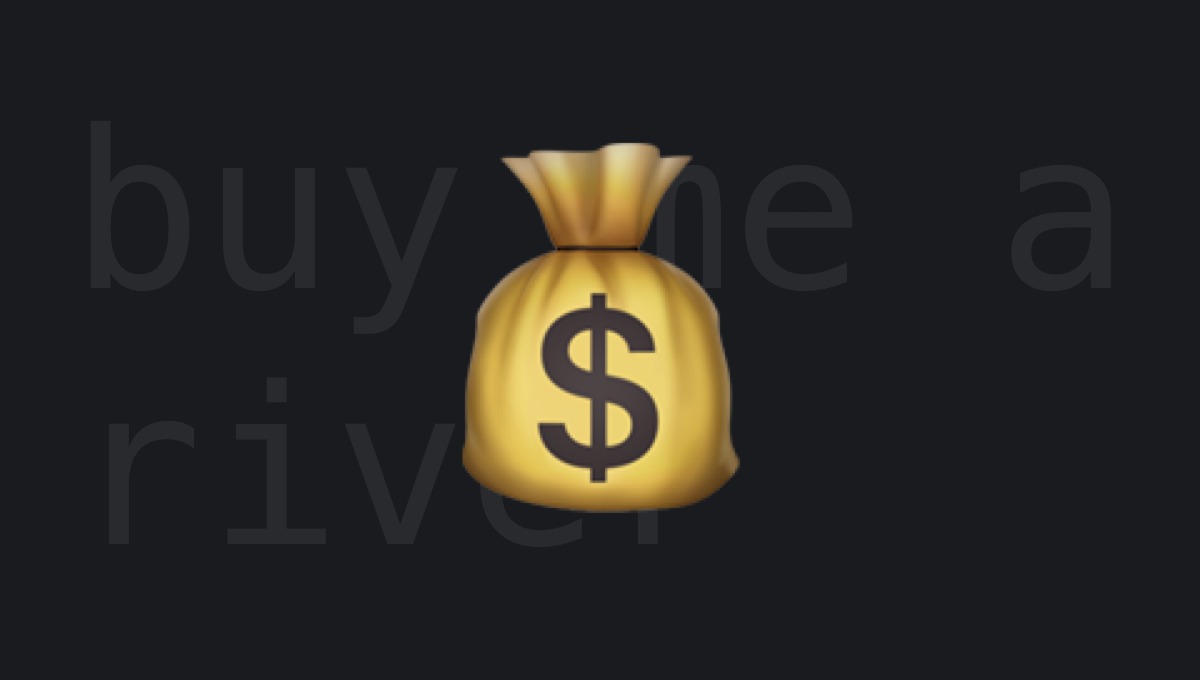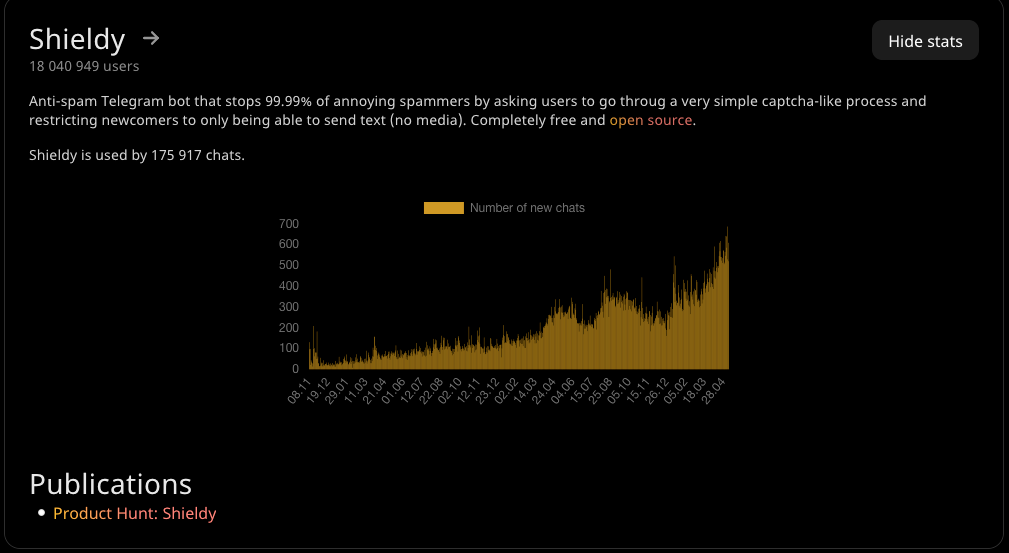How I got multiple offers to buy Shieldy at the same time, rejected them all and why it was the correct decision?
A few people decided to offer me money to buy Shieldy bot simultaneously. Learn how much money does a bot with 18 000 000 users cost in this post

Hello Internet! I have a somewhat interesting story to share today. A couple of months ago I received offers from multiple people to buy one of my projects — @shieldy_bot — for $100 000, $125 000 and $150 000 respectively. I ended up rejecting all three. I'm going to explain not only why I did so but also why it turned out to be the correct decision.
What is Shieldy?
@shieldy_bot is a bot that you add to a group chat on Telegram and forget about 99% of spam in that group instantly. It simply asks all the newcomers to pass captcha and restricts them for a day from posting media afterwards. I position this bot as a zero-config anti-spam solution.
Because it's so simple to use and thanks to its open-source nature, even the largest crypto projects and software projects use it. For instance, I'm extremely proud that even the LibreOffice Telegram groups use it. So far, Shieldy is used by over 18 000 000 users. You can see the real-time stats on my website.

You might notice that the growth is exponential. But wait, is this the user growth? No! It's the growth of the user growth over time! The user growth is even more exponential! And all of this without any money spent on marketing. Server costs? Mere $40/month. I can afford to keep this baby run for free virtually forever, especially thanks to my GitHub Sponsors and Buy Me a Coffee Patrons.
The offers
I was contacted by Telegram users A, B and C with 4 and 7 days between the conversations. I knew none of them and I still don't know their real names. However, I did add all of them to my contact book — and they decided to do the same. We ended our conversations on good notes and ended up agreeing that we might have mutually beneficial business in future.
I'm using the letters as their names to differentiate between these offers and to protect their (even though mostly anonymous) identities. I don't think these offers were from the same person as I first received the highest bid then followed by lower offers. There was no need to lowball me if I rejected a higher offer previously, especially to try doing it twice.
You might think to yourself: why buying something open source? Why not just launch an instance on your own and call it a day? On every occasion, potential buyers were interested in the audience (18 000 000 people) and not the product specifically. Plus the added value of close to no maintenance and marketing costs.
You don't get this by just running an instance of a popular open-source service.
Offer A
I was just finishing my morning coffee when I was contacted by an unknown contact on Telegram. The very first message didn't tell me much about the person but they did ask me about the Shieldy bot's stats. In particular, the user growth over time.
I'm no stranger to unknown contacts on Telegram — my users have direct access to my Telegram handle and they can contact me with whatever questions they have. Anyone can do this. So I simply sent the link to my website and pointed them at the Shieldy stats.
I thought that was it, but the unknown contact then offered me to buy Shieldy without any specifics. I'm always curious about how much money people would want to pay for my projects — it's one of the ways to validate the product. So I played along — what if we could even agree on the price? That would be rad, wouldn't it?
Then they proceeded to offer me $75 000 to buy the bot's token and servers. I'm not sure what was the strategy here offering such an amount of money to a person that they don't know and never worked with, but similar things happened to the other two potential buyers.
Even though this amount of money would hardly contribute to my financial prosperity, I decided to calculate the cost of Shieldy for the very first time myself.
Calculating the price
First of all, I spend ~$40/month to support Shieldy and not a cent more. I don't advertise it, I don't hire developers to add new features. This cost is negligible so I won't even consider factoring it in.
Back when I had my first offer, Shieldy only had a bit more than 10 000 000 users. This was the result 3 years after I launched it. I already had a promo message in the bot leading to one of my products — Todorant — which alone brought me 1000-1200 unique new visitors to the website a day. But this is, obviously, "cold" non-targeted traffic.
Let's say that instead Shieldy would target group admins and brought Telegram group admins traffic to a service that allows them to manage channel posts. They usually cost $5/channel or so. At least that's how I would price them. Let's say that out of 10 000 000 users 2000 admins (0.02% conversion) registered and added 1 channel each (most likely, there would be multiple channels per user but we'll simplify the math here).
This would bring $10 000/month revenue. Multiplying it by 24 months, we get $240 000 of revenue in the first 2 years. Again, no costs whatsoever! And this is just one way to monetize the audience, one of the most naive ones. Possibilities to better monetize the bot are endless. When you have 10 000 000 users, you can perform insane monetization magic.
Taking into account the taxes and fees that we would have to pay to just close this deal, rounding this up to a nice $250 000 shouldn't be an issue. So overall, I think that a good starting point for negotiations can be $250 000 to sell Shieldy. Especially taking into account...
The growth
Even though Shieldy only yielded 10 000 000 users in 3 years of existence, you may notice that the exponential growth just started at the beginning of 2021. This was when 6 000 000 users turned into 10 000 000 users in a short period. Taking into account the Telegram growth, we can say that this trend will continue in the future (and it did, keep reading till the end).
I projected that by the end of 2021 Shiely would double to 20 000 000 users (yes, 100% growth). Which would further increase the audience reach and the potential revenue.
Why was I so sure about the growth? Because this was the beginning of the hockey-stick, the concept I experienced multiple times on a few previous projects I worked on. I saw the beginning, I did not want to sell myself short.
Back to the offer A
I proceeded to lay out the math above to the potential buyer. I'm a good negotiator able to note subtle details about the person's position even over text messages. So I ended up negotiating a 100% increase in the offer price up to $150 000, however, it was still $100 000 short of what I believed was the "deal" price on Shieldy.
I tried to explain the growth trend and how the audience was going to double in a very short timeframe but the person on the other end was adamant.
I decided to call this deal off and asked them to come back in a year with another offer. They did not believe that the product would keep growing, I saw that it would. I told them that in the worst-case scenario for them, I would have been right and they would have lost a golden opportunity. The best case scenario for them would be if the growth would have stopped.
A bit too harsh, but I'm this type of a negotiator when it comes to a "no-deal".
Offer B
This was by far one of the most awkward dialogues I had in my life which I am pretty ashamed of so I won't talk much about it and won't give you too many details. If you're the person I talked to, even though we ended our discussion on a good note, I still sincerely appologize for my misunderstanding of the situation. (However, still "no-deal" on the proposed price, you'll see why later).
This person appeared out of nowhere just like the person A. This time they offered to buy Shieldy for $125 000 in BTC right away. Quite a nice chunk of money, however, still short of my expectations. I tried to negotiate the price up, opening with a substantially higher than what I considered fair (I do it as a general rule when I have enough leverage) — but had no luck.
Because this person was so prepared — they did a lot of homework and even pointed out a couple of unobvious things about the product, I thought they were simply the person A trying to restart the negotiations. I turned out to be wrong in this case and this is partially why my negotiation position lost leverage.
I'm not going to say much, but I would have been extremely happy to work with this company 4-5 years ago. Today though I don't think we can work together unless the offer is good enough. We ended up not closing the deal simply because the price offered was too low.
Why are my expectations so high?
A sidenote on what you might consider arrogance or plain stupidity when rejecting such well-negotiated high offers as the offer A and the coming below offer C.
All negotiation results are the sum of leverages, perceived value and the ability to present the positions correctly. My leverage is my financial independence (I don't need to sell anything) and knowledge about launching and growing products.
Most of the time, when I can't walk out of negotiation without a deal, I don't start the negotiation. I pick my battles and Shieldy price negotiation is that type of a battle where I can just quit with a "no-deal" and call it a day. Call me whatever you want, but when it comes to business, there is no need for emotions.
Offer C
As usual, this person appeared among tens of new contacts I deal with daily in my Telegram inbox. They have also indicated the interest in buying Shieldy but opened with a set of questions on the user count, chat count, user growth, possible monetization strategies.
Fortunately, I had these numbers already prepared and I sent them right away. The initial offer was called. $30 000. You might understand my confusion after the first two offers I had. Not to worry though, I bring up my fair estimate of how much I think Shieldy was worth — $250 000 at that moment.
Over the next couple of days, I negotiated the price up to $100 000, but the person on the other end did not want to pay more. Well, as usual, this was a "no-deal" for me and I simply walked out, leaving my comments about the future growth and how in a year the price would go up simply because the audience would double.
We still ended our conversation in a good faith and agreed that in future we might have common points of interest.
So why was I right to reject the offers?
My estimate of the fair price was mostly based on the audience size. At 10 000 000 users, I estimated the price to be $250 000, not accounting for the future free user growth. This was 2 months ago.
Just imagine this: if any of the three potential buyers have bought Shieldy for $250 000 they would have had to believe in the audience doubling within the next year to further justify the paid price. Would they have been correct?
Hell yeah! In the last 3 months, Shieldy grew 80%. Let me repeat that: it gained 8 000 000 users in the last 3 months!
My projections were wrong. So, so wrong! I expected the audience to double in 12 months. It almost doubled in 3 months! All of this without any extra overhead in server or marketing costs!
If someone bought Shieldy 2 months ago they would have bought a nice hotel with land, only to find out later that it stands on an abandoned but still rich gold mine!
Why does it happen now in 2021?
Honestly, no one ever expressed interest in buying my Telegram bots before. I'm not sure what changed this year. Maybe my bots became more popular? Maybe the fact that I added public stats in mid-2020 changed something? Maybe Telegram got big enough and investment firms decided to diversify their assets to Telegram as well?
I'm not sure what to make of this situation. You'll have to figure out the consequences of this wind of changes yourself.
Conclusion
What does it all mean for the Telegram bot market? First of all, something has changed. I'm not sure why, when and what changed, but people started to be interested in buying projects in the Telegram infrastructure. Which can mean that the market can get an influx of investments or new players.
What's the fair price for Shieldy with 18 000 000 users in my opinion? I'd say 80% higher than with 10 000 000 at least. This is not accounting for the further evidence of sustained user growth without any additional expenses.
I'm for sure not going to regret the decisions to not sell Shieldy at the prices offered. Hope you enjoyed the article!
Cheers!

